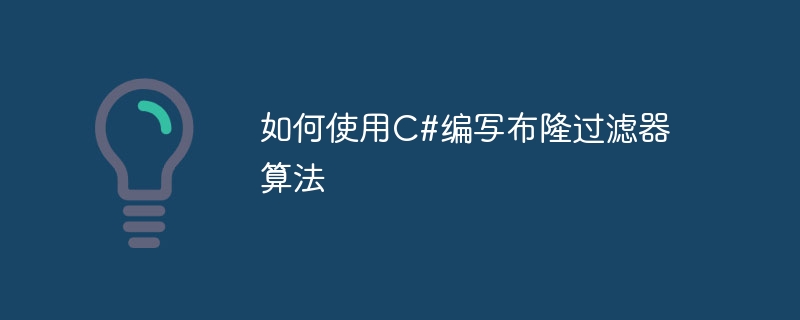如何使用C#编写布隆过滤器算法

如何使用C#编写布隆过滤器算法
布隆过滤器(Bloom Filter)是一种空间效率非常高的数据结构,可以用于判断一个元素是否属于集合。它的基本思想是通过多个独立的哈希函数将元素映射到一个位数组中,并将对应位数组的位标记为1。当判断一个元素是否属于集合时,只需要判断对应位数组的位是否都为1,如果有任何一位为0,则可以判定元素不在集合中。布隆过滤器具有快速查询和占用空间少的特点,在很多场景中得到了广泛应用。
本文将介绍如何使用C#编写布隆过滤器算法,并提供具体的代码示例。
首先,我们需要定义一个布隆过滤器类,并声明一些必要的变量和方法。以下是一个简单的布隆过滤器类的定义:
using System;
using System.Collections;
using System.Collections.Generic;
using System.Security.Cryptography;
public class BloomFilter
{
private BitArray _bits;
private int _hashFunctionsCount;
public BloomFilter(int capacity, double falsePositiveRate)
{
int bitsCount = GetBitsCount(capacity, falsePositiveRate);
_bits = new BitArray(bitsCount);
_hashFunctionsCount = GetHashFunctionsCount(bitsCount, capacity);
}
public void Add(string item)
{
foreach (int hash in GetHashes(item))
{
_bits.Set(Math.Abs(hash % _bits.Length), true);
}
}
public bool Contains(string item)
{
foreach (int hash in GetHashes(item))
{
if (!_bits[Math.Abs(hash % _bits.Length)])
{
return false;
}
}
return true;
}
private IEnumerable<int> GetHashes(string item)
{
using (SHA256 sha256 = SHA256.Create())
{
byte[] hashBytes = sha256.ComputeHash(System.Text.Encoding.UTF8.GetBytes(item));
for (int i = 0; i < _hashFunctionsCount; i++)
{
yield return BitConverter.ToInt32(hashBytes, i * 4);
}
}
}
private int GetBitsCount(int capacity, double falsePositiveRate)
{
return (int)Math.Ceiling(capacity * Math.Log(falsePositiveRate) / Math.Log(1 / Math.Pow(2, Math.Log(2))));
}
private int GetHashFunctionsCount(int bitsCount, int capacity)
{
return (int)Math.Round((double)(bitsCount / capacity) * Math.Log(2));
}
}以上代码定义了一个BloomFilter类,其中包含了构造函数、Add方法和Contains方法。构造函数接收两个参数:容量和误判率,根据这两个参数计算出需要的位数组大小和哈希函数个数。Add方法用于向布隆过滤器中添加元素,将元素通过多个哈希函数映射到位数组中,并将对应位数组的位标记为1。Contains方法用于判断一个元素是否存在于布隆过滤器中,通过多个哈希函数将元素映射到位数组中,并判断对应位数组的位是否都为1。BloomFilter类,其中包含了构造函数、Add方法和Contains方法。构造函数接收两个参数:容量和误判率,根据这两个参数计算出需要的位数组大小和哈希函数个数。Add方法用于向布隆过滤器中添加元素,将元素通过多个哈希函数映射到位数组中,并将对应位数组的位标记为1。Contains方法用于判断一个元素是否存在于布隆过滤器中,通过多个哈希函数将元素映射到位数组中,并判断对应位数组的位是否都为1。
接下来,我们可以使用布隆过滤器类进行测试。以下是一个简单的示例:
using System;
public class Program
{
public static void Main(string[] args)
{
BloomFilter bloomFilter = new BloomFilter(100000, 0.01);
bloomFilter.Add("apple");
bloomFilter.Add("banana");
bloomFilter.Add("orange");
Console.WriteLine(bloomFilter.Contains("apple")); // 输出:True
Console.WriteLine(bloomFilter.Contains("banana")); // 输出:True
Console.WriteLine(bloomFilter.Contains("orange")); // 输出:True
Console.WriteLine(bloomFilter.Contains("watermelon")); // 输出:False
}
}以上示例代码创建了一个布隆过滤器对象,并向其中添加了三个元素("apple", "banana", "orange")。然后,通过Contains
rrreee
以上示例代码创建了一个布隆过滤器对象,并向其中添加了三个元素("apple", "banana", "orange")。然后,通过Contains方法判断一个元素是否存在于布隆过滤器中。需要注意的是,由于布隆过滤器存在一定的误判率,因此在判断一个元素是否在布隆过滤器中时,可能会发生误判的情况。所以,布隆过滤器主要适用于那些可以容忍一定误判率的场景,例如判断一个URL是否已经访问过等。🎜🎜总结起来,本文介绍了如何使用C#编写布隆过滤器算法,并提供了相关的代码示例。布隆过滤器作为一种高效的数据结构,在一些特定场景中具有重要的应用价值。希望本文能对理解和应用布隆过滤器算法有所帮助。🎜以上是如何使用C#编写布隆过滤器算法的详细内容。更多信息请关注PHP中文网其他相关文章!

热AI工具

Undresser.AI Undress
人工智能驱动的应用程序,用于创建逼真的裸体照片

AI Clothes Remover
用于从照片中去除衣服的在线人工智能工具。

Undress AI Tool
免费脱衣服图片

Clothoff.io
AI脱衣机

AI Hentai Generator
免费生成ai无尽的。

热门文章

热工具

记事本++7.3.1
好用且免费的代码编辑器

SublimeText3汉化版
中文版,非常好用

禅工作室 13.0.1
功能强大的PHP集成开发环境

Dreamweaver CS6
视觉化网页开发工具

SublimeText3 Mac版
神级代码编辑软件(SublimeText3)

热门话题
 如何使用C#编写布隆过滤器算法
Sep 21, 2023 am 10:24 AM
如何使用C#编写布隆过滤器算法
Sep 21, 2023 am 10:24 AM
如何使用C#编写布隆过滤器算法布隆过滤器(BloomFilter)是一种空间效率非常高的数据结构,可以用于判断一个元素是否属于集合。它的基本思想是通过多个独立的哈希函数将元素映射到一个位数组中,并将对应位数组的位标记为1。当判断一个元素是否属于集合时,只需要判断对应位数组的位是否都为1,如果有任何一位为0,则可以判定元素不在集合中。布隆过滤器具有快速查询和
 编写C语言中计算幂函数的方法
Feb 19, 2024 pm 01:00 PM
编写C语言中计算幂函数的方法
Feb 19, 2024 pm 01:00 PM
如何在C语言中编写乘方函数乘方(exponentiation)是数学中常用的运算,表示将一个数自乘若干次的操作。在C语言中,我们可以通过编写一个乘方函数来实现这个功能。下面将详细介绍如何在C语言中编写乘方函数,并给出具体的代码示例。确定函数的输入和输出乘方函数的输入通常包含两个参数:底数(base)和指数(exponent),输出为计算得到的结果。因此,我们
 如何使用C#编写动态规划算法
Sep 20, 2023 pm 04:03 PM
如何使用C#编写动态规划算法
Sep 20, 2023 pm 04:03 PM
如何使用C#编写动态规划算法摘要:动态规划是求解最优化问题的一种常用算法,适用于多种场景。本文将介绍如何使用C#编写动态规划算法,并提供具体的代码示例。一、什么是动态规划算法动态规划(DynamicProgramming,简称DP)是一种用来求解具有重叠子问题和最优子结构性质的问题的算法思想。动态规划将问题分解成若干个子问题来求解,通过记录每个子问题的解,
 如何使用C++编写一个简单的学生选课系统?
Nov 02, 2023 am 10:54 AM
如何使用C++编写一个简单的学生选课系统?
Nov 02, 2023 am 10:54 AM
如何使用C++编写一个简单的学生选课系统?随着科技的不断发展,计算机编程已经成为了一种必备的技能。而在学习编程的过程中,一个简单的学生选课系统可以帮助我们更好地理解和应用编程语言。在本文中,我们将介绍如何使用C++编写一个简单的学生选课系统。首先,我们需要明确这个选课系统的功能和需求。一个基本的学生选课系统通常包含以下几个部分:学生信息管理、课程信息管理、选
 如何使用C++编写一个简单的酒店预订系统?
Nov 03, 2023 am 11:54 AM
如何使用C++编写一个简单的酒店预订系统?
Nov 03, 2023 am 11:54 AM
酒店预订系统是一种重要的信息管理系统,它可以帮助酒店实现更高效的管理和更良好的服务。如果你想学习如何使用C++来编写一个简单的酒店预订系统,那么本文将为您提供一个基本的框架和详细的实现步骤。酒店预订系统的功能需求在开发酒店预订系统之前,我们需要确定其实现的功能需求。一个基本的酒店预订系统至少需要实现以下几个功能:(1)客房信息管理:包括客房类型、房间号、房
 如何通过C++编写一个简单的扫雷游戏?
Nov 02, 2023 am 11:24 AM
如何通过C++编写一个简单的扫雷游戏?
Nov 02, 2023 am 11:24 AM
如何通过C++编写一个简单的扫雷游戏?扫雷游戏是一款经典的益智类游戏,它要求玩家根据已知的雷区布局,在没有踩到地雷的情况下,揭示出所有的方块。在这篇文章中,我们将介绍如何使用C++编写一个简单的扫雷游戏。首先,我们需要定义一个二维数组来表示扫雷游戏的地图。数组中的每个元素可以是一个结构体,用于存储方块的状态,例如是否揭示、是否有雷等信息。另外,我们还需要定义
 如何用Python编写KNN算法?
Sep 19, 2023 pm 01:18 PM
如何用Python编写KNN算法?
Sep 19, 2023 pm 01:18 PM
如何用Python编写KNN算法?KNN(K-NearestNeighbors,K近邻算法)是一种简单而常用的分类算法。它的思想是通过测量不同样本之间的距离,将测试样本分类到最近的K个邻居中。本文将介绍如何使用Python编写并实现KNN算法,并提供具体的代码示例。首先,我们需要准备一些数据。假设我们有一组二维的数据集,每个样本都有两个特征。我们将数据集分
 如何使用C#编写二分查找算法
Sep 19, 2023 pm 12:42 PM
如何使用C#编写二分查找算法
Sep 19, 2023 pm 12:42 PM
如何使用C#编写二分查找算法二分查找算法是一种高效的查找算法,它在有序数组中查找特定元素的位置,时间复杂度为O(logN)。在C#中,我们可以通过以下几个步骤来编写二分查找算法。步骤一:准备数据首先,我们需要准备一个已经排好序的数组作为查找的目标数据。假设我们要在数组中查找特定元素的位置。int[]data={1,3,5,7,9,11,13






